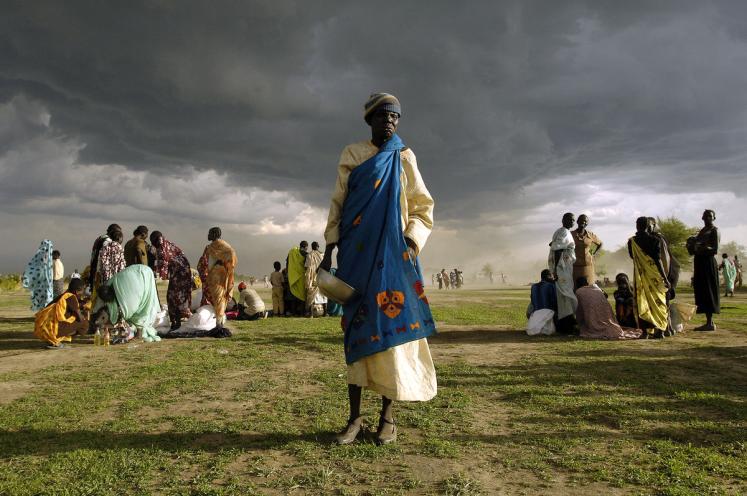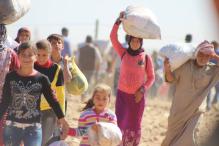In April, UN Women published its new flagship report, Progress of the World’s Women 2015-16. The report is an impressively lucid account of the state of the world’s women, seen through the lens of a ‘human rights-based approach to economic policy’: that is, one which sees the economy not as an end in itself but as a means to improve people’s everyday lived experiences.
The three priorities identified for change – transforming work to benefit women, improving social policies, and creating an enabling macro-economic environment – left this reader wondering to what degree the report’s ‘Agenda for Action’ is relevant to fragile and conflict-affected states, given that they often lack control over such factors.
The report’s only reference to conflict (there is nothing on the broader concept of fragility) is a paragraph on “Constraints on macroeconomic policy in post-conflict settings” (my italics). In stating that “Conflicts undermine the normal functioning of economies”, the authors suggest that conflict is a kind of abnormal ‘blip’ in a state’s proper functioning, and the only solution is rebuilding key institutions in the aftermath of conflict.
However, as we have already pointed out, over the past decade major civil wars have been on the increase, as has their relapse rate. What is more, a large and increasing share of the world’s poor live in fragile and conflict-affected states. Conflict, for many people around the world, is not an anomaly but an enduring state of affairs. If the international community is to respect its commitment to ‘leave no one behind’ in the context of the post-2015 development agenda, addressing gender inequalities cannot be reserved exclusively for the aftermath of conflict.
What effect does conflict have on gender equality?
The Progress of the World’s Women report indicates that poverty and gender inequality have a mutually reinforcing effect, as do conflict and poverty. One may therefore be tempted to assume that gender inequality increases during conflict and, in particular, in fragile states which see frequent outbreaks of violence.1 However, the story is complicated. Indeed, there is evidence to suggest that in some cases conflict may positively affect household and community welfare, for instance by increasing women’s participation in the labor force.2
Gender roles and relations alter during periods of conflict, both for the better and for the worse. Of course, war economies often foster predatory behavior by non-state actors, such as imposition of protection ‘taxes’ or extortion of civilians travelling to and from markets.3 This can have a disproportionately negative effect on women, who are often most likely to be buying and selling goods at markets. However, these informal economies can also work in favor of women by acting as sources of jobs and livelihoods for households.4 Of course, the increased participation of women in the workforce does not necessarily translate to greater empowerment; nor does it always translate into improved bargaining power.5 Any gains that are made often turn out to not be sustained, suggesting that increased participation is a result of temporary necessity rather than permanently shifting gender norms.6
The evidence from conflict-affected and fragile states complicates how we think of women’s economic empowerment. It means that women’s increased participation in the workforce may not necessarily lead to changes in how people think about traditional gender roles. In addition, given that women are sometimes given greater power within conflict economies, national and international security actors must ensure that their objective to “woo a population away from a political economy based on violence” does not have negative developmental impacts, namely the disenfranchisement of women.7 Attempts to control – and destroy – war economies can have negative knock-on effects for households who rely on them: and, as Progress of the World’s Women 2015-16 tells us, women will often bear the brunt of the impact on behalf of their families.8
Why does this matter?
Fragile and conflict-affected countries are the furthest behind in meeting Millennium Development Goals targets. Post-2015, the draft Sustainable Development Goals would commit the world to “Promote peaceful and inclusive societies.” This is a laudable objective. However, given the “conflict trap” that many countries are stuck in,9 and given the evidence showing that gender inequality increases the likelihood of conflict,10 it is also essential that development issues are addressed in those countries that remain conflict-ridden and unstable. This will not be easy: fragile states present challenges when it comes to access, data collection, and sustainability of projects.
Successful initiatives to improve gender equality and reduced poverty levels – as pointed to in the report – could have an important knock-on effect for more structural issues in conflict: it seems unlikely, for instance, that a woman whose basic livelihoods are not taken care of would be able to participate in peace processes. Aside from the direct benefits on the women themselves, improved levels of gender equality in conflict-affected and fragile states could therefore indirectly foster the inclusion of women at all levels of society in peace and reconciliation processes.
The idea that “development approaches can empower women in the most fragile environments” is not new, yet it does not seem to be widely applied. The number of long-term development initiatives taking place in protracted conflict settings remains low, and resilience is still a handy buzzword rather than a reality. However, in order for development initiatives to fulfil their promises to “leave no one behind” it is essential that the issues faced by conflict-affected and fragile states are not situated solely in the security sphere. This includes debates around gender.
What can be done?
Too often, women’s experiences in conflict are discussed only in the context of sexual and gender-based violence, which ignores more structural issues of inequality and reinforces the image of women as sexualized victims. Applying the three key areas for action in the 2015 report on Progress of the World’s Women to conflict-affect and fragile settings could help to remedy this, as long as the nuances explained above are taken into account:
1. Transforming work for women’s rights
Actors working on job creation in fragile contexts must ensure that the needs of both women and men are addressed in their programming. Disarmament, Demobilization and Reintegration programs during conflict have repeatedly faced problems, for instance, because they fail to address how Reintegration affects the wider community, beyond direct beneficiaries. In their approaches, these activities must take into account the dynamics within entire communities, recognizing that conflict disrupts gender relations. There is thus an opportunity for positively influencing gender norms and empowering women, but also a need to be sensitive to the emasculation often felt by male ex-combatants. Such approaches are less likely to create resentment towards women involved in such programs. Moreover, state-building activities which look to weaken non-state armed groups through targeting their markets must ensure that these actions do not have unintended negative consequences on women (see the case of mining in DRC, where ‘conflict free’ requirements have had some indirect negative impacts on local miners).
2. Making social policy work for women
In fragile and conflict-affected countries, the state is often unwilling and/or unable to provide social welfare services, with local organizations and INGOs filling the gap. However, the longevity of these external programs is often not guaranteed and they tend to leave local capacities and knowledge insufficiently improved. Intractable conflicts make it clear that efforts to assure a smooth transition from humanitarian to longer-term social protection initiatives must be scaled up, including through better capacity development plans and long-term, more flexible funding from donors which allows for training and local capacity building. There are some examples of best practice around this; more is needed. Unconditional cash transfers have also been shown to increase women’s control over household finances and can act as an effective buffer for vulnerable groups. When selecting projects, donors should specifically require clear gender indicators of the proposed approach, along with evidence that no other approach has proven more effective in shrinking gender inequalities.
3. Creating an enabling global environment for the realization of women’s rights
UN Women’s call for the creation of “an enabling global environment for the realization of women’s rights” is commendable but also vague and potentially unworkable. But the idea of creating this global environment is key: as the report recognizes, the institutions currently working on development “exacerbate, rather than mitigate, the gender bias in macroeconomic policy.” The political will to meaningfully change gender dynamics is missing. At most, donor reporting and financial incentives encourage actors in fragile states to pay lip service to women’s rights. Attitudes are still not changing on the ground. On a project level, donors should ask that evaluations include not only quantitative but also qualitative figures that reflect women’s participation, including through interviews with the most vulnerable groups of both women and men on their perception of how – and whether – these initiatives have impacted on their lives and livelihoods.
[1] Paul Collier (2004) ‘Development and Conflict’, Department of Economics, Oxford University: “The relationship between civil war and failures in development is strong and goes in both directions: civil war powerfully retards development; and equally, failures in development substantially increase proneness to civil war.”
[2] Patricia Justino (2012) ‘Women Working for Recovery: The Impact of Female Employment on Family and Community Welfare after Conflict’, UN Women.
[3] Mark B. Taylor (2013), ‘Conflict financing: what’s wrong with war economies?’, Norwegian Peacebuilding Resource Centre Report. James Cockayne (2010) ‘Crime, Corruption and Violent Economies’, Adelphi series Special Issue: Ending Wars, Consolidating Peace: Economic Perspectives, Volume 50, Issue 412-413;
Steven Van Damme (2012) ‘Commodities of War’, Oxfam International Briefing Paper 164; Oliver Lough, Richard Mallett and Paul Harvey (2013) ‘Taxation and Livelihoods: A Review of the Evidence from Fragile and Conflict-Affected Rural Areas’, International Centre for Tax and Development, Working Paper 11.
[4] Tsjeard Bouta, Georg Frerks and Ian Bannon (2005) ‘Gender, Conflict and Development’, The World Bank.
[5] Calderón et al (2011) ‘Forced Migration, Female Labour Force Participation, and Intra-Household Bargaining: Does Conflict Empower Women?’
[6] Bouta et al (2005) ‘Gender, Conflict and Development’.
[7] Cockayne (2010) ‘Crime, Corruption and Violent Economies’.
[8] Ibid.
[9] Collier (2004) ‘Development and Conflict’.
[10] Marcia E. Greenberg and Elaine Zuckerman (2006) ‘The Gender Dimensions of Post-Conflict Reconstruction: The Challenges in Development Aid’, UNU-WIDER Research Paper No. 2006/62.
Suggested citation: Hannah Cooper., "Leaving No One Behind: Addressing Gender Inequalities in Conflict," UNU-CPR (blog), 2015-06-09, https://unu.edu/cpr/blog-post/leaving-no-one-behind-addressing-gender-inequalities-conflict.



